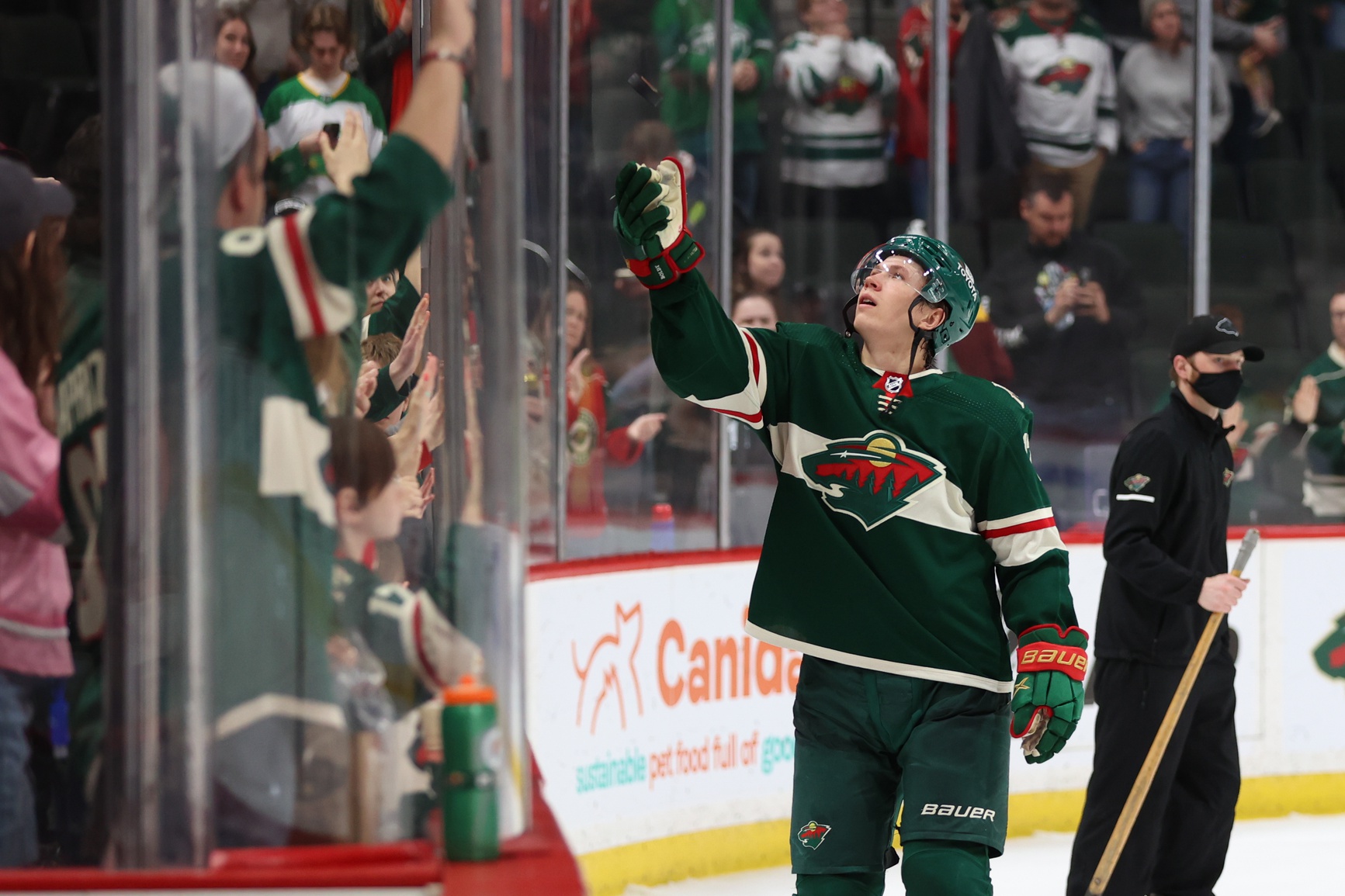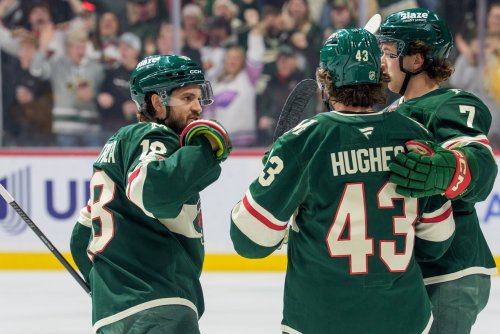
For the first time in franchise history, the Minnesota Wild look like a model draft-and-develop team. Kirill Kaprizov burst onto the scene as a rookie in the 2021 season, taking home a Calder Trophy. Still, there were doubts over whether this was a fluke or not. Not just with Kaprizov's 27 goals and 17% shooting percentage, but whether the only reason Minnesota's pipeline succeeded was that a 23-year-old developed into a star overseas.
Turns out, neither was a fluke. Because Kaprizov turned into an impact player, and the Wild system turned out another one in Matt Boldy. The former Boston College forward graduated to the NHL this past year and dazzled Wild fans in 47 games. Boldy's point production (15 goals, 39 points) lagged behind Kaprizov's 51-point rookie year, but not by much. Kaprizov averaged 0.93 points per game in his rookie season. Boldy averaged 0.83.
That gap is much closer than their average points per game suggests. A deeper look reveals that Boldy was every bit as much of a star as Kaprizov or Kevin Fiala. He also managed to do that not as a 23-year-old, fully-developed rookie like Kaprizov, or a 25-year-old, six-year veteran like Fiala. He did this at age 20, with only 24 pro games under his belt.
Just how impressive was he for his age group? Since 2007-08, only 18 players averaged more than three points per hour in all situations (500+ minutes) at age 20. Boldy ranks 11th among this elite group, with 3.24 points per hour.
The names ahead of him are no joke, either. We're talking Sidney Crosby, Connor McDavid, Taylor Hall, Jack Hughes, Mathew Barzal, Auston Matthews, Patrick Kane, Steven Stamkos, Matthew Tkachuk, and Mikko Rantanen. Boldy is in extremely rarified air.
It seems that a player like Boldy should be hyped as the next big star for Minnesota in any other season. Instead, he's almost overlooked. Sure, Kaprizov's undeniable "It" factor and Minnesota's pending Fiala trade understandably take up a lot of oxygen. But Kaprizov followed up his strong rookie season with a brilliant sophomore campaign. Why can't Boldy do the same? Should we expect a big step from a 21-year-old Boldy?
To determine that, let's look at the list of the age-20 Three Point-Per-Hour Club and figure out how they did their next seasons. WE have to eliminate Hughes and Boldy. Their rookie seasons came this year, and we don't know how they will follow them up. But that leaves 16 names, with Nicklas Backstrom, Alex DeBrincat, Elias Pettersson, David Pastrnak, Phil Kessel, Mitch Marner, and Brock Boeser as the previously unmentioned players we'll look at.
The first thing we want to look at is: How repeatable was their offensive production? We could look to their age-21 seasons specifically, but that can go up and down based more on injuries than talent level.
So instead of looking at just age-21, let's look at their body of work from ages 21 through 25. There are players like Matthews or Pettersson who aren't yet 25, so this may not be perfect. But a big-picture look will give us a decent idea of whether they could keep up that big season.
The good news for Boldy is that if you average 3-plus points per hour at 20, you're probably the real deal. Half of the 16 names on our list averaged 3 points or more per hour from ages 21 through 25. That doesn't even include folks like Patrick Kane (2.99 points per hour) and Stamkos (2.95), who just barely missed the mark.
There's a ton of upside in this group and almost no downside. Only one player on the list was even below 2.6 points per hour from ages 21 to 25. That distinction belongs to Boeser, who at 2.46 points per hour still manages to be a Top-100 scorer (89th) over the past four seasons.
So depending on where you want to draw the Superstar line, it's 8-10 times likelier, at least going off this sample, that Boldy will be a superstar than a mere top-100 scorer like Boeser. Recent history is very, very kind to young players who accomplished what Boldy did.
But hey, points aren't everything, you may say. You wouldn't be wrong. Some players can post big point totals that don't necessarily translate to winning games. What's the likelihood Boldy becomes one of those players?
Again, the answer appears to be slim-to-none. Let's look at how that group does in terms of Standings Points Above Replacement. A season worth 5 points in the standings is, in a full 82-game season, about what the 50 best players in the NHL get every year. So let's start there for our cutoff in looking at this group. 12 of the 16 players we're looking at averaged 5.0 or more SPAR per 82 games from ages 21 through 25. A 13th (DeBrincat) just missed the cutoff at 4.9 SPAR per 82.
As for the three others, Boeser is a strong-but-not-elite player (3.6 SPAR per 82), while Kessel (3.1) and Barzal (2.9) are both hurt by poor defense. The latter is probably not a worry for Boldy. He provided positive defensive value last season.
The news even gets better from here. Eight players among these 16 averaged 6.0 SPAR per 82, putting them in the top 25 to 30 range in the NHL for most seasons. Once again, if you're elite at 20, chances are pretty good that you'll stay elite, especially since Boldy had 4.7 SPAR at age 20, in just 47 games.
Some may worry whether Boldy can keep up his play without Fiala as a linemate. Yes, Fiala's transition game and sniping ability certainly helped Boldy make a splash. But the chemistry they showed can be replicated thanks to Boldy's skills. For example, many gifted transition players, like Marco Rossi, could benefit from Boldy's vision and puck possession ability.
We've already seen it. In pre-season, the duo looked very comfortable with each other. That continued into their six AHL games together, where the duo racked up nine points each. Add in top power-play time alongside Kaprizov and Mats Zuccarello, more 5-on-5 time to shine, and that Boldy's shot looks pretty good, and there's no reason Boldy can't thrive without Fiala.
Judging by the other players whose footsteps he's following, it's practically a guarantee. What Boldy did last season is so hard to do that the only players who can tend to be the very best in the game. Even the players that fell short of those expectations, like Barzal or Boeser, are still top-line players in their own right.
With the focus on established stars like Kaprizov and Fiala, the State of Hockey is still sleeping a touch on Boldy. That's understandable. It's not going to be the case for long, though. The Wild's latter great rookie is poised for a dominant five-year run. And after all this time of hyped prospects failing to develop for Minnesota, it will be a treat for fans to watch.
Think you could write a story like this? Hockey Wilderness wants you to develop your voice, find an audience, and we'll pay you to do it. Just fill out this form.







Recommended Comments
There are no comments to display.
Join the conversation
You can post now and register later. If you have an account, sign in now to post with your account.
Note: Your post will require moderator approval before it will be visible.